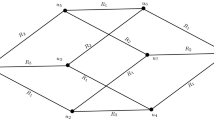Abstract
Recently, in Almallah et al. (New Math Nat Comput, to appear) and Borzooei et al. (New Math Nat Comput 16(2):397–418, 2020), we defined the concept of inverse fuzzy graph as a generalization of graph, which is able to answer some problems that graph theory and fuzzy graph theory can not explain. And as we know planarity is very important and applicable concept in graph theory and fuzzy graph theory, so our motivation in this paper is discussion the importance of planarity in inverse fuzzy graphs. Now, in this paper we define the notion of inverse fuzzy multigraph and the concept of planarity on it by using the concepts of intersecting value and inverse fuzzy planarity value. Then we introduce some related theorems which determining upper bounds and lower bounds for the inverse fuzzy planarity value. After that we define the strong (weak) planarity of an inverse fuzzy multigraph and investigate related results. Finally, we give an application of inverse fuzzy multigraphs to decision-making how to reduce the cost of travel tours.








Similar content being viewed by others
References
Almallah R, Borzooei RA, Jun YB, Domination numbers of inverse fuzzy graphs with application in decision-making problems, New Mathematics and Natural Computation, to appear
Berge C (2001) Theory of graphs and its applications. Dover publication, USA
Borzooei RA, Rashmanlou H, Samanta S, Pal M (2016) A study on fuzzy labeling graphs. J Intell Fuzzy Syst 30(6):3349–3355
Borzooei RA, Almallah R, Jun YB, Ghaznavi H (2020) Inverse fuzzy graphs with applications. New Math Nat Comput 16(2):397–418
Cao W, Gao J, Ming Z, Cai S, Shan Z (2018) Fuzziness-based online sequential extreme learning machine for classification problems. Soft Comput 22:3487–3494
Cao W, Gao J, Ming Z, Cai S, Shan Z (2017) Fuzziness based random vector functional-link network for semi-supervised learning, International Conference on Computational Science and Computational Intelligence (CSCI)
Cao W, Gao J, Ming Z, Cai S, Shan Z,(2020) An improved fuzziness based random vector functional link network for liver disease detection, IEEE International Conference on Big Data Security on Cloud (BigDataSecurity), High Performance and Smart Computing (HPSC) and Intelligent Data and Security (IDS)
Eslahchi Ch, Onagh BN (2006) Vertex strength of fuzzy graph. Int J Math Math Sci 43614:1–9
Jaiswal R, Rai S (2016) Application of fuzzy graph coloring in traffic light problem,. Int J Innov Res Sci Eng Technol 5:6950–6955
Lavanya S, Sattanathan R (1998) Fuzzy total coloring of fuzzy graphs. Int J Inform Technol Knowl Manage 2(1):37–39
Mohammadzadeh E (2021) A graph associated to a polygroup with respect to an automorphism. J Algebraic Hyperstruct Logical Algebras 2(1):99–112
Mordeson JN, Mathew S (2020) Sustainable goals in combating human trafficking: analysis by mathematics of uncertainty. J Algebraic Hyperstruct Logical Algebras 1(1):49–59
Mordeson JN, Mathew S, Malik DS (2018) Fuzzy graph theory with applications to human trafficking. Springer, Berlin
Mordeson JN, Mathew S, Malik DS (2018) Fuzzy graph theory. Springer, Berlin
Rashmanlou H, Samanta S, Borzooei RA (2016) Product of bipolar fuzzy graphs and their degree. Int J General Syst 45(1):1–14
Rosenfeld A (1975) Fuzzy graphs. In: Zadeh LA, Fu KS, Shimura M (eds) Fuzzy sets and their applications. Academic Press, New York, pp 77–95
Sunitha MS, Mathew S (2013) Fuzzy graph theory, a survey. Annals Pure Appl Math 4(1):92–110
Tutte WT (2001) Graph theory. Cambridge University Press, Cambridge
Zadeh LA (1965) Fuzzy sets. Inform Control 8(3):338-353
Author information
Authors and Affiliations
Corresponding author
Ethics declarations
Conflict of interest
The authors declare that there is no conflict of interest.
Human and animal rights
This article does not contain any studies with human participants or animals performed by any of the authors.
Additional information
Publisher's Note
Springer Nature remains neutral with regard to jurisdictional claims in published maps and institutional affiliations.
Rights and permissions
About this article
Cite this article
Borzooei, R.A., Almallah, R. Inverse fuzzy multigraphs and planarity with application in decision-making. Soft Comput 26, 1531–1539 (2022). https://doi.org/10.1007/s00500-021-06681-6
Accepted:
Published:
Issue Date:
DOI: https://doi.org/10.1007/s00500-021-06681-6




